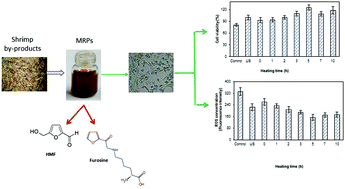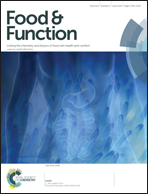The Maillard reaction of a shrimp by-product protein hydrolysate: chemical changes and inhibiting effects of reactive oxygen species in human HepG2 cells
Abstract
Recently, much attention has been given to improving the antioxidant activity of protein hydrolysates via the Maillard reaction, but little is known about the cellular antioxidant activity of Maillard reaction products (MRPs) from protein hydrolysates. We first investigated chemical characterization and the cellular antioxidant activity of MRPs in a shrimp (Litopenaeus vannamei) by-product protein hydrolysate (SBH)–glucose system at 110 °C for up to 10 h of heating. Solutions of SBH and glucose were also heated alone as controls. The Maillard reaction greatly resulted in the increase of hydroxymethylfurfural (HMF) and browning intensity, high molecular weight fraction, and reduction of the total amino acid in SBH with the heating time, which correlated well with the free radical scavenging activity of MRPs. MRPs had stronger inhibiting effects on oxidative stress of human HepG2 cells than the original SBH, and its cellular antioxidant activity strongly correlated with free radical scavenging activity, but less affected by the browning intensity and HMF level. The caramelization of glucose partially affected the HMF level and free radical scavenging activity of MRPs, but it was not related to the cellular antioxidant activity. The cellular antioxidant activity of MRPs for 5 h of heating time appeared to reach a maximum level, which was mainly due to carbonyl ammonia condensation reaction. In conclusion, the Maillard reaction is a potential method to increase the cellular antioxidant activity of a shrimp by-product protein hydrolysate, but the higher HMF levels and the lower amino acid content in MRPs should also be considered.


 Please wait while we load your content...
Please wait while we load your content...